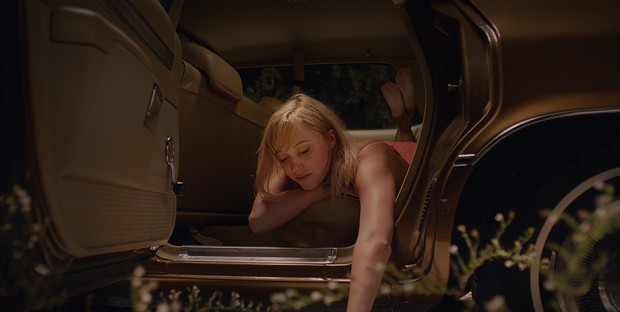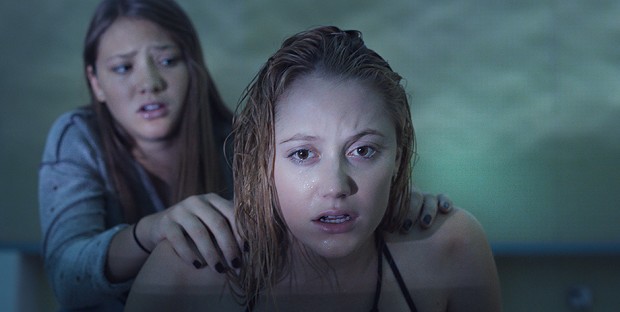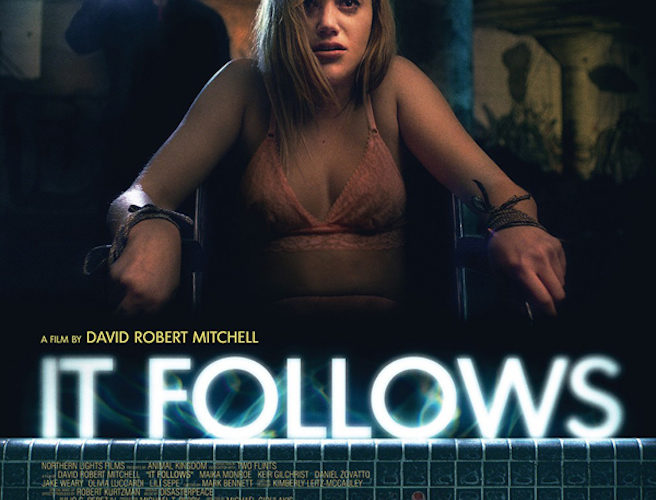A teenage girl, captured through a static wide shot, runs through a quaint Detroit suburb, her body dwarfed by its trees and middle-class homes. The sense that something is not as it seems becomes realized quite quickly. This prologue, while one of the most formally well-executed sequences in the film, sets up a certain expectation, and luckily It Follows isn’t so much interested in that now-tired the-evil-that-lurks-under-the-surface-of-small-towns brand, but rather its invasion onto the iconography of it.
Naturally, all a part of this equation are teenagers, yet in this case their boredom and leisure are our first impression of them; our soon-to-be-terrorized heroine, Jay (Maika Monroe), is lounging in the pool as the supporting cast watches television and reads off small hand-held devices. They’re all childhood friends with a history that suggests both a tightly knit group, as well as even unrequited love. Jay finds some excitement in a date with a stud, though the eventual problems of their sexual encounter are neither pregnancy nor disease, rather a haunting, shape-shifting spirit that will slowly follow until it kills her. The rule is this: the curse won’t leave her until she passes it on to another sexual partner. In the meantime, she has to convince her friends of her situation, all while wondering if she should truly just go to the length of finding another person to pass it to.

Writer/director David Robert Mitchell has, with only two films, made clear his preoccupations: well-worn coming-of-age tropes and an emphasis on their seemingly mundane minutia. The problem with his previous film, The Myth of the American Sleepover, was that it seemed content in just being an accumulation of gestures, taking a group of teenagers on a late-summer weekend and letting their sexual inexperience and insecurities be the base of the entire film. While there’s still some misguided stabs at “naturalism” in this, it’s fortunate that the added genre kick of It Follows adds some much-needed dramatic ambition to his thematic concerns, even if the film’s flaws come somewhat in its failure to completely realize certain implications.
While smart enough to dart away from its potentially conservative, anti-sex message — considering the beautiful young bodies of our heroes as opposed to saggy old ones most often manifested in the spirit’s form — the specters of It Follows seems to suggest not just the literal threat of death, but even the worry of aging and, furthermore, unattractiveness — the kind of forms that naturally and forever reside in this suburban purgatory.

Yet if Mitchell is more concerned with making another Halloween than The Brood, he certainly succeeds. Orchestrating a number of jump scares with surprising grace, the film quotes John Carpenter with its scope lensing, yet also earns the comparison: the open spaces of each home, landscape, and depressed Detroit vista feel like they could spawn the sudden appearance of the haunting spirit.
All the more evocative is a synthesized score by Disasterpeace that resembles Master Carpenter at his most aggressive — and, even, Argento favorite Goblin at their silliest. This aspect seems to place Mitchell’s film in the territory of self-awareness, though where it really comes to crack, even somewhat, is in enforcing some logic to its premise. This is especially the case in its nonsensical climax , the forcing of special effects confrontations onto the film revealing the limits of its concept, for its spirit proves much scarier as a looming presence than a pouncing monster.
Luckily enough, this is followed by the film’s subtle, most emotionally effective passage: its final minutes, which make one think that perhaps they’d underestimated the clearness of this film’s themes.
It Follows screened at TIFF and hits theaters early next year. See our complete coverage below.


